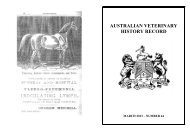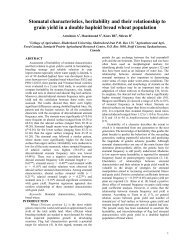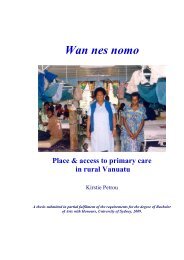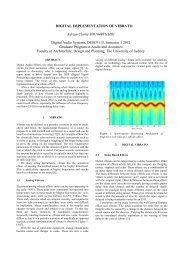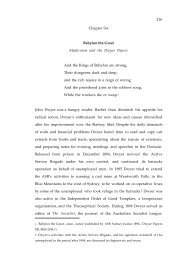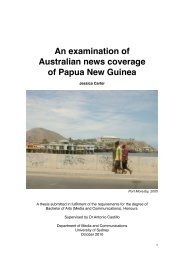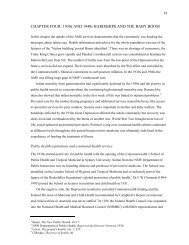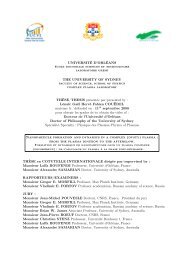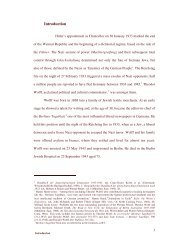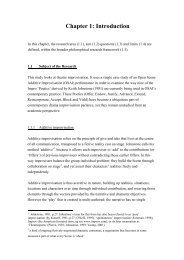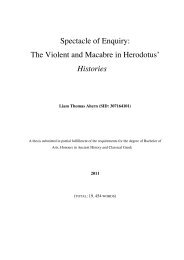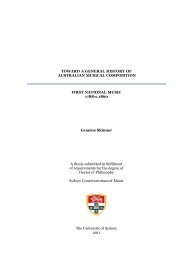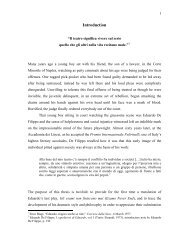Chapter 6: Tense, aspect and mood
Chapter 6: Tense, aspect and mood
Chapter 6: Tense, aspect and mood
Create successful ePaper yourself
Turn your PDF publications into a flip-book with our unique Google optimized e-Paper software.
Suffixes<br />
3: -lhvka- ‘go’<br />
C[-coronal] a]+<br />
NP1 -ya -lhvki-ya<br />
NP2 -ja -lhvka-ja<br />
NP3 -ma ~ -ngvma -lhvkv-ma ~ -lhvka-ngvma<br />
P1 -Ø -lhvka-Ø<br />
P2 -rnv ~ -nv -lhvka-rnv ~ -lhvke-nv<br />
REFL -jungwV- (-lhaba-jungwV-)<br />
RECP -yi- -lhvkee-yi-<br />
CAUS -ji- -lhvka-ji-<br />
Table 6.7: Conjugation 3: -ja, -rnv ~ -nv (verb stems ending in /a/)<br />
This conjugation contains the thematics +ba- <strong>and</strong> +ka- (see Table 5.9), <strong>and</strong> the verb -lhvka- ‘go’,<br />
as listed in (10).<br />
(10) Class 3 (3 roots)<br />
Thematic +ka- Thematic +ba- (3 examples) -lhvka- ‘go’ 6<br />
(e.g. -lhawurr+ka- ‘taste, try, test’ ( -lhek+ba- ‘accuse, blame’<br />
-arnda+ka- ‘hunt’ -lhaba ‘taste, try, test’<br />
-wal+ka- ‘sneak up on’ -kwiyerrba ‘make a mistake’)<br />
-lharr+ka ‘send’<br />
-ngurr+kwa- ‘hunt’)<br />
The majority of verbs in this conjugation are composed of thematic +ka-, which may derive<br />
historically from the stem *-ka- ‘carry’ (cf. pGN *ka- ‘take, carry’). However, this verb no longer<br />
exists separately <strong>and</strong> no synchronic segmentation is viable (Heath 1984: 470 suggests the same for<br />
Wubuy).<br />
6.3.4 Conjugation 4: -na, -Ø [JH class 8C (-na, -a); JW (-ina, -a; -una, -a); VL: - 7 ]<br />
This class is characterised by the P2 ending -Ø. The stem-final vowel in this class is /a/, which is<br />
preserved in all environments except in the NP2 <strong>and</strong> one allomorph of the NP3, where it is<br />
weakened to [əә]. Table 6.8 presents the paradigm, <strong>and</strong> some verb roots belonging to this class are<br />
listed in (11). This is the only conjugation where there is no formal distinction between P1 <strong>and</strong> P2;<br />
these are thus glossed ‘PST’ in the examples (e.g. [21b] below).<br />
6<br />
This verb does not contain thematic +ka-, but derives from alhvka ‘NEUT.foot’, which in turn may be related to<br />
Ritharrngu rluku ‘foot’ (pPN: *luku [Alpher 2004]).<br />
7<br />
Leeding (1989) does not identify this verb class, which is probably because tense suffixes are optional in her<br />
analysis. The absence of a tense suffix has the same effect as the -Ø suffix proposed here. According to Leeding, any<br />
verb without an inflectional suffix can represent either past or non-past tense. This is however a huge<br />
overgeneralisation, because the tense/<strong>aspect</strong> suffixes are mostly obligatorily realised by overt material. In conjugation<br />
3 above, for instance, the only category that is realised as -Ø is the P1; all other categories take non-null suffixes.<br />
210



